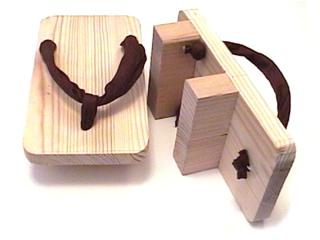Japanese Geta
Traditional Wooden Platform Sandals


June 2004


June 2004
At last summer's Pennsic war, I attended a class on making traditional Japanese woven straw sandals called waraji. I actually made one waraji (warajum?) in the class, but I knew that if I took it home I would never make a matching one.
What captured my imagination were geta, the raised wooden sandals worn today during festivals and with traditional clothing. I knew that I probably had the woodworking skills necessary to make them, but I needed more information about the parts and dimensions of real geta, since I dind't have a pair to study.
Enter The Geta Page and its marvelous resources. This page will tell you nearly everything you might want to know about geta, and has some instructions (sadly incomplete) for making geta. The instructions include a way to calculate the dimensions of geta appropriate for your feet.
The instructions recommend making a scratch pair from scrap wood before investing time and money into a fair pair. I saw no reason not to heed this advice, so my first pair were made from pine boards (soles) and pine 2x6 (teeth, or ha). They came out OK, though I took some shortcuts with the straps (or hanao) that make them uncomfortable to wear. Namely, I just covered some sisal rope with cloth. Scratcheriffic!
For the second pair, I used much nicer poplar wood and spent the time to make nicer hanao from cloth and cotton padding. They are very comfortable, though I still need a lot of practice walking in them. They're not strictly traditional, but they look very good. Sharon's making us some kosode and hakama, so these will be a nice addition to provide a "base" for the costume.
I get most of my wood from the Home Depot, which does not carry the paulownia wood that is traditionally used for geta. Paulownia is very light, like balsa wood, but is stronger and actually very durable with a high strength to weight ratio. Poplar is a little denser, but still lighter than something like oak, and has a good strength. It's also more attractive than pine, and still available at the Home Despot. The entire project used less than four feet of poplar 1x6 lumber.
The hanao are made from cotton cloth, cotton padding, and jute twine. I later found that the straps are supposed to be much flatter than I made them, but since the instructions on The Geta Page don't get that far, I was flying pretty blind.
(I've since found a source of paulownia wood. Paulownia Wood Supply says that they have supplied blocks for geta in the past, and if I decide to make another pair I'll definitely try to get some.
The poplar only comes in a single thickness of about 3/4 inch, so before I could start I first had to make thicker wood for the hanao and thinner wood for the soles. I glued two thicknesses of poplar together with wood glue, then cut them to length for the ha and trimmed them with the band saw to the proper thickness. I also used the band saw to resaw the sole pieces to the thickness they are supposed to have, (…which just barely worked. I need a planer, but they are expensive.) and shape the corners of the soles.
While the glue attaching the ha to the soles was drying, I went upstairs to the sewing room to make the hanao. I had some black cotton cloth, so I sewed it into a long tube. Then, I wrapped some cotton quilt batting around a length of jute twine and turned the tube inside-in onto it. This made a very soft strap with a strong core of jute.
Once the hanao were complete, I drilled the required holes in the geta for attaching them. I cut the big strap in half to make two straps, and stripped some of the padding from the inside so the cloth and twine would fit through the holes. The toe strap is another length of cloth tube without any padding or twine.
I made these in December of 2009. They're made from the same wonderful cedar I used to make shoji screens.
I put a linseed oil finish on the to make the grain pop and protect the wood from water and dirt a bit more. I made the straps by sewing fabric tubes and pulling rolls of cotton batting into them. I even braided some silk yarn to make the "between the toes" bits that hold the straps down.
I planed the sole pieces in a friend's planer, and drilled the holes for the straps on the drill press, but most everything else was done by hand. I cut all the pieces to length by hand, rounded the corners by hand, planed the "teeth" by hand, and cut the joinery for the teeth by hand.